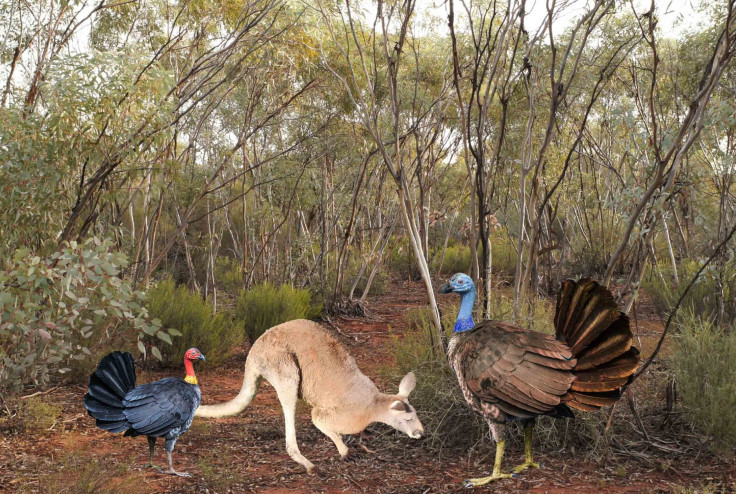New Species Fossil: Extinct Australian Turkey As Big As Kangaroo

The birds that lived in ancient Australia included a turkey that could fly and was as big as a kangaroo.
Paleontologists from Flinders University recently identified five large extinct birds called megapodes that are related to animals that can be found today, including the malleefowl, an endangered ground-dwelling bird roughly the size of a chicken, and brush-turkeys, known for their dark plumage and bright colors on their heads. Their five ancient relatives lived during the Pleistocene era, which ran from 2.6 million to 12,000 years ago and also hosted species like marsupial lions and short-faced kangaroos.
All of the five extinct birds are large, the university reported, ranging from 6.5 pounds to 17.5 pounds, compared to the malleefowl’s comparably humble 4.5 pounds. But the giant brush-turkey’s size dwarfs the others — Progura gallinacea was as tall as a gray kangaroo, with long, slender legs.
Read: DNA Links Indigenous Australians to Country’s First Human Settlers
Scientists analyzed existing fossils from around Australia to identify and reclassify the new species, their study in the journal Royal Society Open Science said. The bones from the Progura gallinacea were the oldest studied. Other extinct species identified included those with short legs and broad bodies. The researchers grouped them into the categories “tall turkeys” and “nuggetty chickens.”
Although scientists had previously thought these dead birds belonged to the same species, one that eventually evolved into the smaller malleefowl we know today, the research shows they were distinct animals.
Altogether, the species greatly add to the number of known megapodes in Australia’s prehistoric past.
“These discoveries are quite remarkable because they tell us that more than half of Australia’s megapodes went extinct during the Pleistocene, and we didn’t even realize it until now,” researcher Elen Shute said in the Flinders statement. “We compared the fossils described in the 1880s and the 1970s with specimens discovered more recently, and with the benefit of new fossils, differences between species became really clear.”
The university said the ancient birds probably buried their eggs in warm soil but roosted in trees: “While big and bulky, their long, strong wing bones show they could all fly.”
Read: The Ocean Is Hiding Thousands of Dinosaur Tracks
The Pleistocene era during which these giant birds flew through Australia is the same time period during which humans first migrated there although that happened near the end of the era. It was about 50,000 years ago that ancient humans — the ancestors of today’s aboriginal tribes — crossed a land bridge to what is now Australia and settled it.
However, even though they would have encountered species that are extinct today, those ancient Australian natives may never have crossed paths with the huge birds described in this study. The researchers noted there is no evidence humans either encountered or hunted any of them. But there is still much to learn.
“Our research shows how little we know of Australia’s immediate prehuman avifauna,” researcher Trevor Worthy said. “Probably many smaller extinct species also await discovery by paleontologists.”
© Copyright IBTimes 2024. All rights reserved.





















